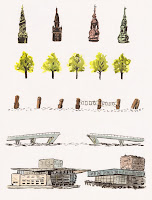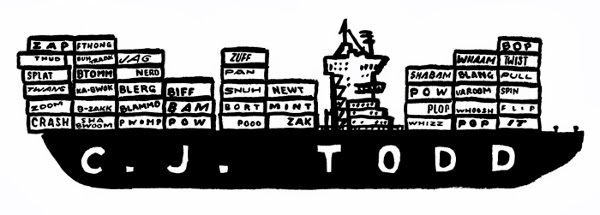I've been on holiday and I need to tell you about it. I'm turning the lights off, so settle down for my slideshow, with a flexidisc of local music in the background and a plate of well-travelled foreign sweets.
Copenhagen from (nearly) the water and (nearly) the air
 |
The view from the waterside steps of Amaliehaven,
including the opera house and the royal theatre. |
The first thing that Adam and I did, after leaving bags at the hotel and finding coffee and cake, was to go up the Rundetårn for a view. The first impression is that Copenhagen is bristling with spires and steeples and spirals and spikes. I filled a page with towers of all kinds and in all directions, not knowing yet which were the main sights.
 |
| The view from the Rundetårn, on the first day, and the Glyptoteket, on the last. |
I fixated upon the "pile-of-onions" construction, which I suppose has a proper name. There will be a half-dome on top of a balcony, on top of an onion dome, balanced on a ring of balls, on top of an another onion dome, on top of a colonnade, on top of another dome, on top of a belfry. The most important buildings are topped off with a series of crowns before the weathervane and cross.
The little roof café of Illum department store became one of our favourite places to drink coffee and play with panoramic functions. On the last day we found another terrace, on top of the Glyptoteket (helpful translation:
Glyptotek), a large museum of antiquities, palms and impressionism. It's right by Tivoli gardens and the fairground rides that are the source of screams that punctuate the day.
 |
The opera house and royal theatre again,
with the new bridge. |
The waterfront gives a different kind of view. Studded along it are grand modern edifices: the Royal Library (the "Black Diamond"), the Royal Theatre, the Opera House, modern apartment blocks and now a new sliding bridge from Nyhavn to Christianshavn.
I spent a lot of time sitting and sketching, changing cartridges over, letting watercolours dry - or giving up and taking photos to work from later.
Nyhavn is the main tourist strip, being a picturesque row of coloured harbourside houses. If you've seen a guidebook to Copenhagen or Denmark, it's probably on the cover. For those arriving on tours, it's the first destination. Coming from any other direction, as I did, it is currently obscured a little by the ongoing work on a new underground line. I'm a sucker for a lightship, so here is the Gedser Rev.
 |
| The colourful waterside buildings of Nyhavn. |
Building and Buildings
Building work is a peppercorn in the sugarbowl of urban holidaymaking. It's hard not to be disappointed when the picturesque fountains are dry, the boulevard is being torn up and the station is surrounded by fences. I've already mentioned the underground work in Copenhagen, and I'm sure it's a wonderful thing in the long term. Rosenborg Castle was semi-shrouded. A local paper showed one of the statues being lifted from the roof for safety during renovation.
 |
| The sculpture garden at Louisiana. |
Two departures, outside Copenhagen
We took a train up the Öresund coast to Humlebæk to visit Louisiana. The gallery holds 20th century modern art, ancient pottery and a temporary exhibition of Yoko Ono, but the main attraction was the garden full of Danish and international sculpture. I sat on the manicured lawn, first in very gentle rain and later in hot sun, drawing the stones and looking across to Sweden.
A few miles further north is Helsingør. Being not only the setting of Hamlet, but the shortest journey for booze-cruising Swedes, everything is as cartoonishly Danish as possible, in its run-down way. The streets are hung with flags; the ferries chug in and out, and the shops declare the price comparisons for various spirits. Adam calls it a cross between Dover and Stratford-upon-Avon. I started drawing on the train back, thinking that I must look like the most patriotic little Danish boy, filling a page with red and white flags.
 |
| Danetastic Helsingør. |
People are worth drawing too
To finish off, here is a jumble of people. I've arranged them for a two-page spread in a newspaper, which I hope will all go ahead in the next few weeks [EDIT:
it did!]. I didn't get to include the English morris men, some of whom were on our flight home, after performing on the waterfront. Airports are not easy when you're covered in bells.
 |
| A spread of people drawn on holiday. |











